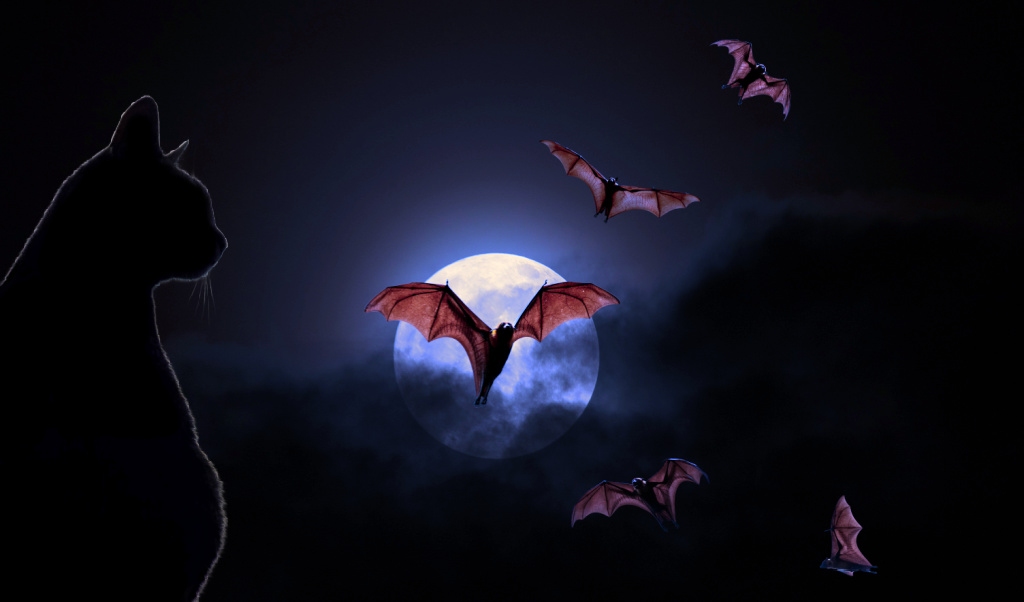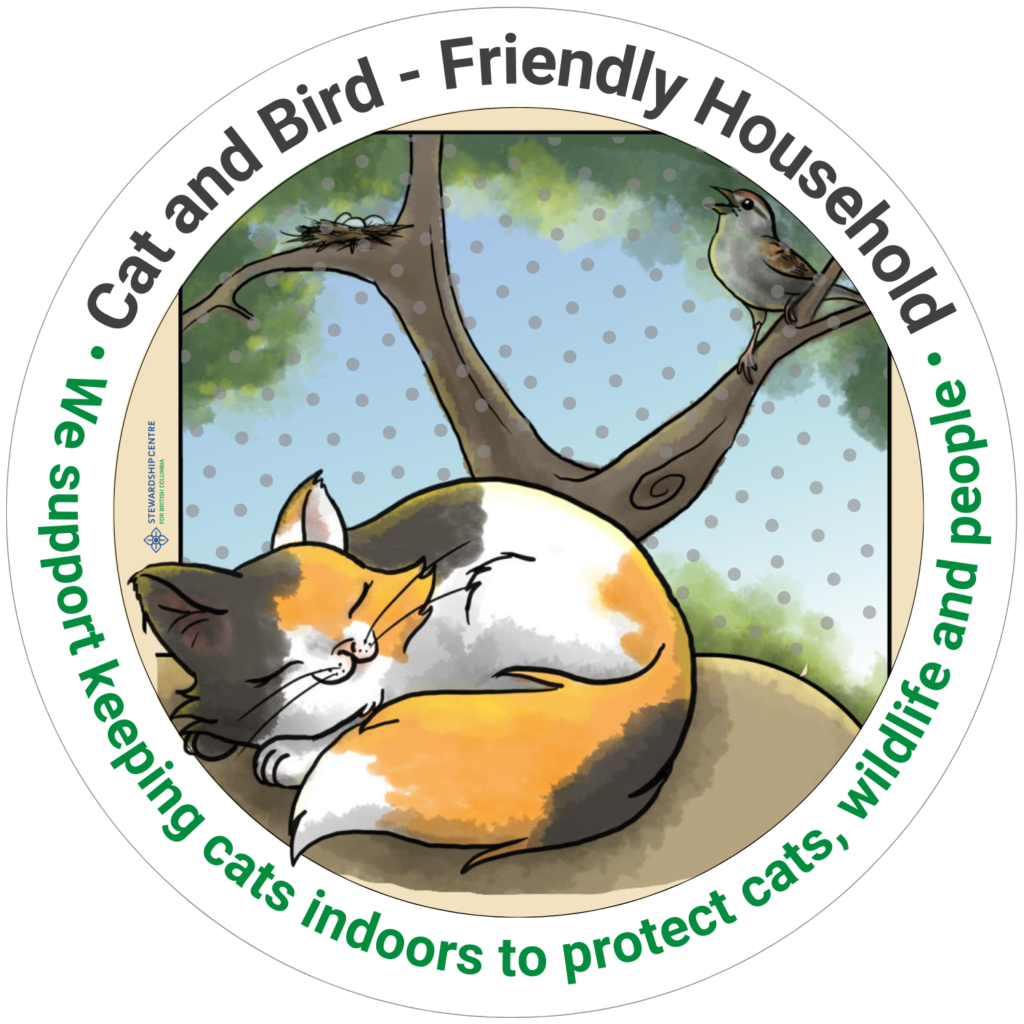
Cats and Bats
Bats in British Columbia
British Columbia is a batty place! It is home to 18 species of bats, representing the highest diversity of bats in Canada. Six species are listed as at-risk by the B.C. Conservation Data Centre, meaning that their populations are endangered or threatened. Twelve occur more commonly.
Bats play a key part in our diverse ecosystems: they help by controlling insects in agricultural, forested and urban environments, pollinating plants, and fertilizing soils with their guano. Furthermore, they are fascinating mammals – capable of flight, echolocation, nocturnal lifestyle, and hibernation or migration. Unfortunately, bats are threatened worldwide and are at risk across the globe.
There are several threats endangering bats: habitat loss, climate change, diseases (like white-nose syndrome), pesticides, sound pollution, persecution by humans, wind turbines, collisions with vehicles and predation by outdoor cats. While some threats need to be addressed at a larger scale by governments and industry, community members can provide help on the ground and protect bats (especially maternal bat colonies) from cat predation by keeping cats indoors and only allowing them supervised and restricted outdoor access to prevent free-roaming.
Cat Predation on Bats
Cat predation is a serious threat to biodiversity and conservation as well as a source of zoonotic disease spread to most wildlife, including bats. Bats that roost or forage near human settlements are most susceptible to predation by cats; these areas include urban, suburban, and agricultural areas, as well as parks and protected areas near human centres (Welch, 2017).
Recording cases of cat predation on bats is challenging, but in literature, there are records of cats predating on at least 48 bat species and in at least 20 countries other than Canada and the USA, further confirming that cat predation is a worldwide and highly prolific issue for bats and other wildlife (Salinas-Ramos et al., 2021). For example, in New Zealand, during a 7-day period, one roaming cat was found to predate on more than 100 male and female roosting bats at two colonial roost trees (Scrimgeour et al., 2012).
A recent study in Canada reported that over six thousand bat mortalities were examined for Rabies over a six-year period (Wilson et al., 2022). From this sample, 16% of bat mortalities came from British Columbia. The majority of mortalities were due to cat predation, contributing to 60% of bats killed by cats in British Columbia. This was the province with the highest percentage of cat-related bat mortalities than other provinces and territories of Canada. The same study also showed that an outdoor cat had twice the likelihood of catching a bat with Rabies than an indoor cat. Thus, cat predation is not only a threat to bats but also a health concern to cats and cat owners.
From 2019 to 2021, the Stewardship Centre for BC has been collecting information about cat-related wildlife injuries from various rehabilitation centres in British Columbia. We found that, on average, 3200 wildlife are admitted due to cat attacks every year. Thirty-seven bats were treated during this time period for cat-related injuries. Bat species caught by cats included Little Brown Myotis (Endangered in Canada), Big Brown Bat, California Myotis, Long-eared Myotis, and Yuma Myotis.
Protect Bats in Your Community
Engage in bat-friendly stewardship to prevent bat mortalities and support overwintering and reproducing bats in your area! Below are simple ways you can protect bats in your community:
- Cats are major predators of bats as well as birds. Keep cats indoors, leash walk or use a catio. Find more information for cat owners on our website and in our Happy Cat Brochure
- Plant native species as well as plants with light-coloured and night-blooming flowers to attract nocturnal insects for bats to forage on. Be sure to remove invasive species that can affect insect communities and even harm bats (such as Burdock, Arctium minimus).
- Retain dead and dying trees when safe to do so. Damaged trees provide roosting habitat for bats under bark flakes, in cracks and crevices, and in woodpecker cavities. If you don’t have any roosting habitat, consider providing several well-built bat boxes to provide roosts in a range of temperatures. See https://bcbats.ca/bat-boxes/
- Turn off unnecessary lights to create a dark haven. Learn about light pollution and how to make lighting more wildlife- (and human-) friendly by following the lighting basics (only be on when needed, only light the area that needs it, be no brighter than necessary, minimize blue light emissions, eliminate upward-directed light)
- Remove any potential bat traps from the garden area – upright buckets and bins can attract insects and then foraging bats, who may not be able to fly out of the bin
- Provide a water feature for thirsty bats. Bats drink while flying so need water features that are at least one metre wide and several metres long, with shallow areas to grow invertebrate prey and open water, free from plants, for drinking at. If you have a swimming pool or a pond, add escape features so any clumsy juvenile bats that get stuck in the water can have a way to climb out
- Avoid using pesticides as they will affect native insects. Insect populations are already declining around the world – and our BC bats all eat insects!
For more information about bats, bat conservation, research and other bat related initiatives in British Columbia, visit BC Community Bat Program website: https://bcbats.ca/
For more information about responsible cat ownership, catios, leash training, indoor enrichment for cats and more, browse our Cats and Birds pages, information for cat owners and other ways to help cats live a better life while protecting ecosystems.
References
Lausen, C. L., Nagorsen, D. W., Brigham, R. M., Hobbs, J. (2022). Bats of British Columbia (Second, Ser. Royal British Columbia Museum handbook). Royal BC Museum.
Salinas-Ramos, V. B., Mori, E., Bosso, L., Ancillotto, L., & Russo, D. (2021). Zoonotic Risk: One More Good Reason Why Cats Should Be Kept Away from Bats. Pathogens, 10(3), 304. https://doi.org/10.3390/pathogens10030304
Scrimgeour, J., Beath, A., & Swanney, M. (2012). Cat predation of short-tailed bats ( Mystacina tuberculata rhyocobia ) in Rangataua Forest, Mount Ruapehu, Central North Island, New Zealand. New Zealand Journal of Zoology, 39(3), 257–260. https://doi.org/10.1080/03014223.2011.649770
Welch, J. N. (2017). Conservation Biology of Bats: Invasive Threats, Research Effort, and Extinction Risk [UniversityofTennessee]. https://trace.tennessee.edu/utk_graddiss/4508
Wilson, A. G., Fehlner-Gardiner, C., Wilson, S., Pierce, K. N., McGregor, G. F., González, C., & Luszcz, T. M. J. (2022). Assessing the extent and public health impact of bat predation by domestic animals using data from a rabies passive surveillance program. PLOS Global Public Health, 2(5), e0000357. https://doi.org/10.1371/journal.pgph.0000357




